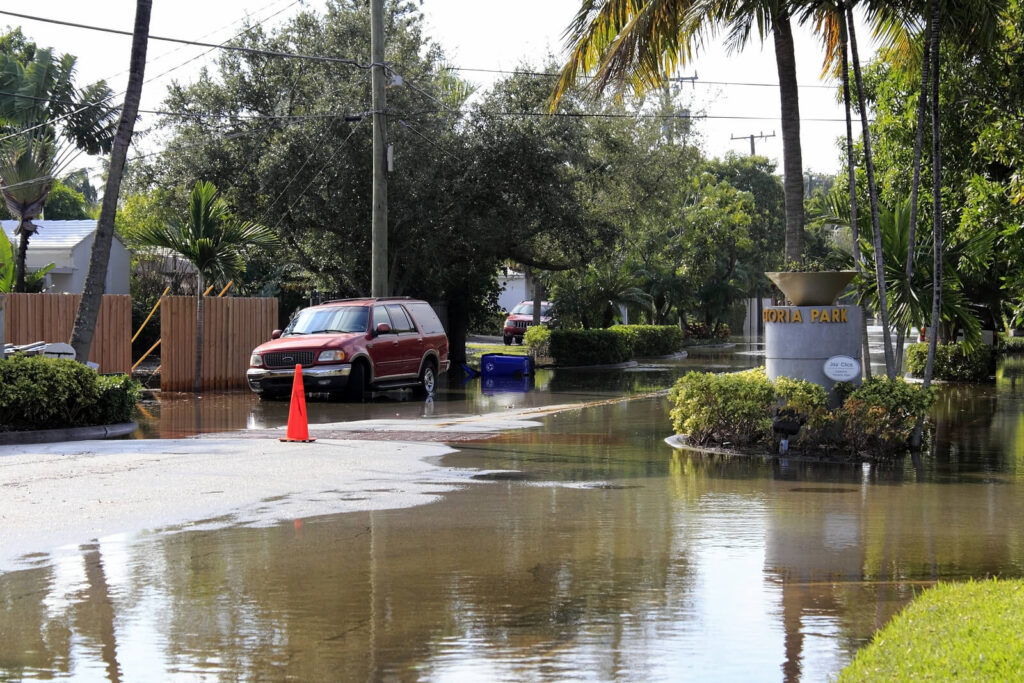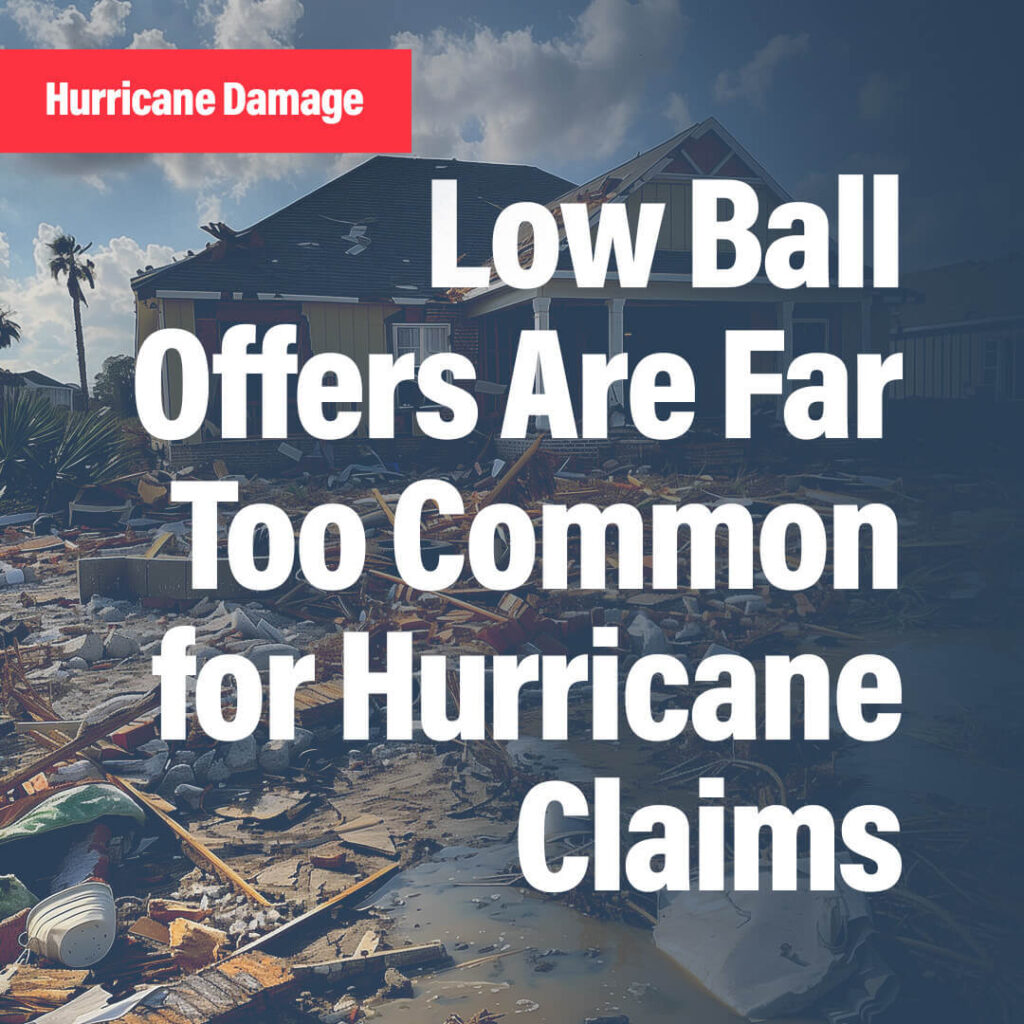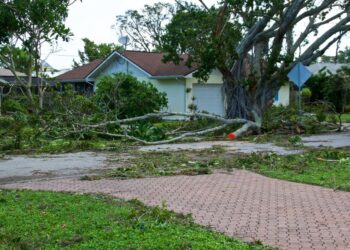Navigating Filing a Damage Claim after Hurricane Helene & Hurricane Milton
-
By
Marc Wites
-
November 19, 2024

Table of Contents

Ready to hire a lawyer? Complete the form below and we’ll connect you with a hurricane damage lawyer.
Table of Contents
For 28 years, I’ve helped homeowners file flood claims after a hurricane. It’s a detailed and time-consuming process, especially since homeowner’s insurance and flood insurance are often separate policies. Below I’ve outlined the steps to take for each based on FEMA guidelines and general insurance procedures:
Steps to File Your Homeowner’s Insurance Claim
Homeowner’s insurance typically covers wind, hail and other storm-related property damage. However, it doesn’t cover flood damage, which is why a separate flood policy is often necessary. Here’s how to proceed with a homeowner’s insurance claim:
- Document the Damage: Before any cleanup, thoroughly document the storm damage. Take clear photos and videos of all affected areas, both inside and outside your home, including structural damage, roof issues, broken windows, and any personal property loss. FEMA advises that this initial documentation is critical for processing your claim.
- Contact Your Insurance Company: Call your insurance company as soon as possible to report the damage and initiate your claim. Explain the extent of the damage clearly, and have your policy number on hand. Most insurance providers will offer guidance on what to expect and how long the process may take.
- Complete a Detailed Inventory: List all damaged or lost personal belongings and note their estimated values. Photos of these items can further substantiate your claim. Some insurers may require receipts or previous pictures of valuable items to verify their worth.
- Secure the Property: Make temporary repairs as necessary to prevent further damage. Save all receipts for materials and labor since insurers may reimburse you. For instance, if there’s a roof leak, you might temporarily cover it with a tarp to avoid worsening the damage.
- Schedule an Adjuster Inspection: Your insurance company will likely send an adjuster to assess the damage. Make sure to be present during this inspection, guiding them to areas of concern and providing any additional documentation you have. Their assessment will form the basis for your settlement.
- Review Your Claim Settlement: Once the adjuster completes their evaluation, your insurance company will issue a claim settlement offer. Carefully review it with your insurer or a professional advisor to ensure it aligns with the repair and replacement costs.
- File for Additional Assistance if Needed: In some cases, you might disagree with the offered settlement. You can appeal or seek a second opinion, and some homeowners choose to consult a public adjuster or attorney for more complex claims.
Steps to File Your Flood Damage Insurance Claim
Flood insurance, often provided through the National Flood Insurance Program (NFIP), follows a separate, federally governed process. Here’s how to file a claim for flood-related damage:
- Report the Flood Damage Immediately: Contact your flood insurer or the NFIP directly to report the flood loss. It’s essential to notify them promptly, as waiting could delay your payout. Be sure to have your flood policy number and details of the damage ready.
- Document the Flood Damage: As with homeowner’s insurance, documentation is key. Before removing any water-damaged items, take photos and videos of the water line and affected areas. FEMA recommends photographing each room’s water line to show the extent of flooding.
- Prepare an Inventory of Flood-Damaged Items: List all belongings affected by the flood and document their condition. Include photos and note the approximate value of each item.
- Remove Standing Water and Prevent Mold: After documenting everything, remove any standing water and dry out the space to prevent mold. This will also help avoid any further structural or health hazards.
- Meet the Adjuster for Inspection: The NFIP or your flood insurance provider will assign an adjuster to evaluate the flood damage. They will provide documentation, such as a Proof of Loss form, to confirm your claim. Be prepared to show your documentation and discuss the extent of the loss.
- Submit the Proof of Loss Form: The Proof of Loss is an official statement of the damage. Once completed, it must be signed, submitted, and approved by the insurance provider, typically within 60 days of the flood event.
- Receive and Review the Payment: Upon approval, the flood insurance provider will issue a settlement. As with homeowner’s insurance, review the settlement offer and discuss any discrepancies with your insurer or adjuster.
Both types of claims require detailed documentation, prompt reporting and close communication with your insurance company. By following these steps, you can ensure a smoother claims process, enabling timely repairs and compensation after a hurricane.
How an Attorney Can Help You with Filing Your Damage Claim
An experienced property damage attorney can be an invaluable resource, helping ensure that you receive the compensation you need in a timely manner. Here are some of the ways an attorney can help streamline the claims process and work toward maximizing your recovery.
Expediting the Claims Process
Hurricane and flood damage claims can sometimes be delayed due to the sheer volume of claims after a major storm. Insurance companies may prioritize some claims over others, leaving policyholders with long waiting periods.
An attorney will work directly with the insurance company to push your claim to the forefront, ensuring it receives the attention it deserves. We know the intricacies of the claims process and can address any missing documentation or discrepancies that might delay the process, keeping your claim moving forward efficiently.
Maximizing the Amount of Your Claim
In my experience, insurance companies often try to minimize payouts, offering settlements that may not cover the full extent of the damages.
Your property damage attorney will review your policy to ensure you’re getting the maximum compensation you’re allowed. We’re skilled negotiators who can counter lowball offers by presenting detailed documentation of damages, repair estimates and other evidence to substantiate the actual cost of your loss.
Hiring a lawyer will help you secure a fair and just settlement that accurately reflects your damages.
Handling Communication with Insurers
Communicating with an insurance company, especially after a disaster, can be exhausting. Insurance adjusters might ask complex questions or request specific information that can be confusing for policyholders.
Your attorney will act as your advocate and handle all the communication with the insurance company on your behalf. This will save you time and minimize misunderstandings while ensuring that your claim is presented accurately and professionally.
Additionally, with our experience in the industry, attorneys can recognize and respond to any tactics your insurance company may use to reduce their liability. This will protect your interests throughout the process.
Ensuring Timely Payments
After a large-scale disaster like Hurricane Helene, funds from insurers can be depleted quickly as they pay out claims to multiple policyholders. By involving an attorney early on, you can help secure your position in line for compensation. This can be essential to ensure you obtain your funds before the reserves run low.
An attorney’s efforts to expedite and manage the claim help ensure you receive your funds sooner rather than later, which is imperative for beginning necessary repairs and replacements.
Assistance if a Claim is Denied
In some cases, an insurance company may deny a hurricane or flood claim. Attorneys are well-prepared to handle these situations, working to appeal denials, gather evidence, and, if necessary, take the case to court. Legal representation can be invaluable in complex appeals, helping you achieve a fair resolution and obtain the compensation you deserve.
By hiring an attorney, you can avoid many of the obstacles and frustrations of dealing with insurance companies alone, making the recovery process quicker and smoother.
Why You Should Hire an Attorney Over a Public Adjuster
When filing a hurricane insurance claim, homeowners often consider hiring a public adjuster or a lawyer. Both professionals aim to help you get the maximum payout, but their roles and fees differ, which can influence your choice.
Public adjusters are licensed to assess damage, document losses and negotiate settlements on behalf of homeowners. They typically charge up to 10% of the insurance payout. Public adjusters are often a cost-effective option for straightforward, small claims, as they can handle most aspects of the claim process except for providing legal advice.
However, property damage lawyers bring additional legal skill and experience, which is particularly valuable if an insurance claim is denied or if the insurer offers an unfair payout. Unlike public adjusters, lawyers can file lawsuits, represent you in court, and give legal advice, which is beneficial if your claim faces disputes.
Many lawyers charge a 10% fee if the case is resolved before going to court, though fees generally increase to around 30% if a lawsuit is necessary. If you initially hire a public adjuster and later require a lawyer, you may end up paying both fees, potentially totaling 40% of the claim payout. Considering these facts, many homeowners opt to hire a property damage lawyer over a public adjuster from the outset.
Steps to Apply for Disaster Assistance from FEMA if You Don’t Have the Proper Insurance
If you’ve experienced damage from a disaster but don’t have the appropriate insurance, applying for FEMA Disaster Assistance can help cover some of the losses. Here’s a guide to the application process and key steps to take.
Apply Promptly
After a disaster, such as in the case of Hurricanes Helene and Milton, time is of the essence. Apply for assistance as soon as possible. Start by visiting DisasterAssistance.gov, downloading the FEMA app, or calling 1-800-621-3362. Registering quickly will secure your place in line for support. You can also text “DRC” to the number 43362 and put in your home ZIP code to locate different disaster recovery centers and the mobile disaster recovery centers in your area.
Document All Damages
Thorough documentation is critical. Take photos and videos of the damage, noting the date and time. Keep any repair receipts and records of temporary housing costs. This documentation provides vital evidence to support your claim.
Complete the FEMA Inspection
After applying, FEMA may arrange an inspection to assess the damage. During the inspection, provide accurate information and point out all areas of loss. Virtual inspections may also be available depending on the disaster and region. Be prepared to answer questions about your home, belongings, and specific losses.
Review Eligibility for Other Assistance Programs
FEMA disaster assistance can cover expenses not typically covered by insurance, such as temporary housing, essential home repairs, and certain disaster-related medical costs. Check if you’re eligible for Small Business Administration (SBA) low-interest disaster loans for homeowners and renters as well, which can provide additional financial aid for home and personal property repairs.
Stay Updated on Your Application
After applying, monitor your application status online and respond promptly to any requests from FEMA for additional documentation or information. You can also appeal any decisions if you disagree with FEMA’s assessment.
Applying for disaster assistance without insurance may seem overwhelming, but following these steps can help expedite the process and improve your chances of receiving much-needed support.
Updates on Applying for Disaster Assistance
Following the devastation from Hurricanes Helene and Milton, FEMA has allocated substantial funds to support both individuals and communities affected by the storms. As of October 16, 2024, FEMA has approved nearly $2 billion in federal assistance across six impacted states (Florida, Georgia, Tennessee, South Carolina, North Carolina, and Virginia). This includes $441 million in direct aid for individuals affected by Hurricane Helene, as well as $349 million for public assistance funding to help rebuild essential infrastructure.
Individual support covers needs like rental reimbursement for those displaced from their homes and emergency cash infusions of $750 to cover essentials like food and diapers. FEMA encourages all those impacted to register on their website as soon as possible to see what aid they might be eligible to receive.
FEMA Administrator Deanne Criswell confirmed that FEMA’s disaster relief fund remains capable of meeting the immediate needs for Helene and Milton. Congress replenished the fund with an additional $20 billion in early October, bringing the current available balance to approximately $8.5 billion. However, Criswell warned that supplemental funding from Congress will be necessary to sustain ongoing disaster relief efforts, as nearly half of the fund is already committed to past disasters.
Without additional funding, FEMA may enter “immediate needs funding,” prioritizing only life-saving efforts in new emergencies. Congress is anticipated to address this issue after the upcoming election.
Ready to hire a lawyer? Complete the form below and we’ll connect you with a hurricane damage lawyer.

Marc A. Wites is a founding shareholder of The Wites & Rogers with over 28 years of trial experience and has achieved great results for his clients. Marc has a natural talent for litigation and a passion for representing policyholders in their disputes against major insurance corporations.
The post Navigating Filing a Damage Claim after Hurricane Helene & Hurricane Milton appeared first on Attorney at Law Magazine.

